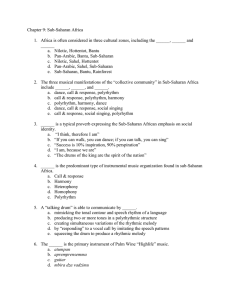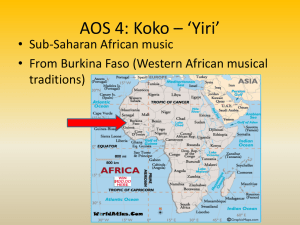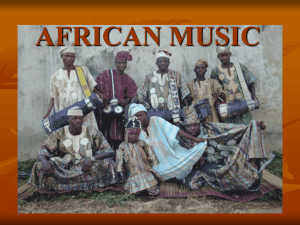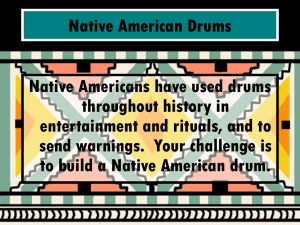Music of Sub-Saharan Africa: Ghana, Congo, Zimbabwe & More
advertisement
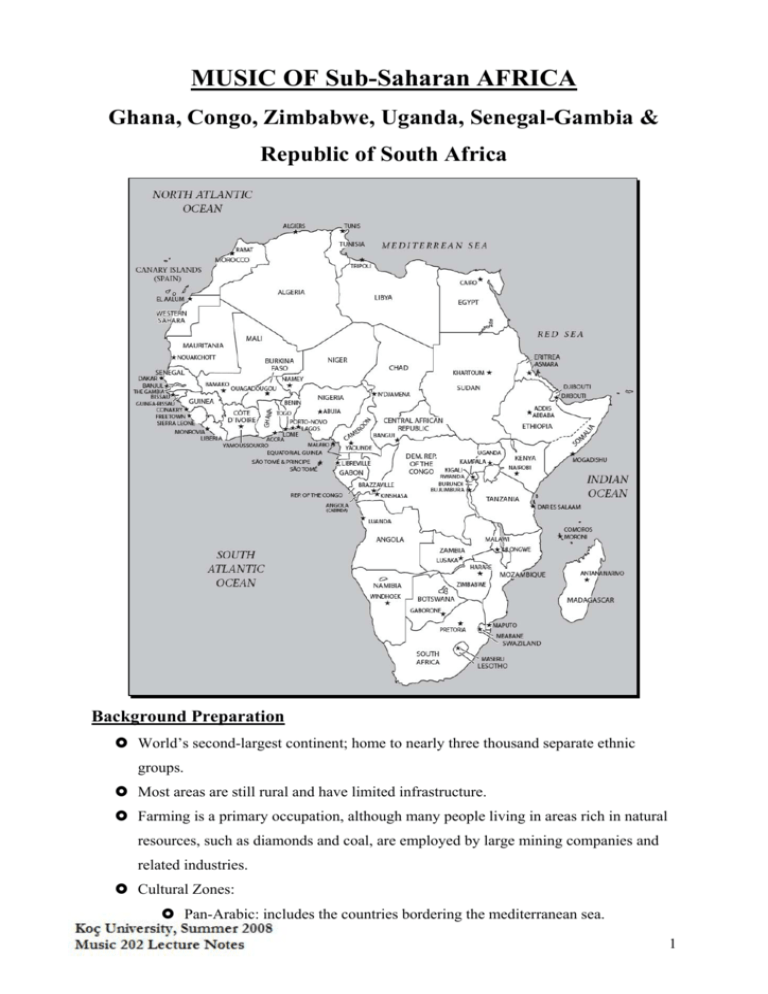
MUSIC OF Sub-Saharan AFRICA Ghana, Congo, Zimbabwe, Uganda, Senegal-Gambia & Republic of South Africa Background Preparation } World’s second-largest continent; home to nearly three thousand separate ethnic groups. } Most areas are still rural and have limited infrastructure. } Farming is a primary occupation, although many people living in areas rich in natural resources, such as diamonds and coal, are employed by large mining companies and related industries. } Cultural Zones: } Pan-Arabic: includes the countries bordering the mediterranean sea. 1 } The Sahel zone: including those areas dominated by the Sahra desert. } Sub-Saharan Africa: rest of the continent, south of the Sahara desert. } Nearly 3,000 separate ethnic groups } Roughly 1,800 spoken languages } European languages common due to decades of European presence & colonialism. } The political borders of present-day Africa are the result of European colonial occupations (19th century & early 20th century) } 1884 Berlin Conference: European countries and governments that had no colonial stake in the region (ex. U.S.A), divided the territorial right to most central and southern Africa without the presence or participation of a single African. } New African nations were formed with little regard for the cultural differences of the various peoples contained within their borders. } Though colonialism affected many of the cultural activities of African peoples, traditional practices still thrive throughout the continent, especially in rural areas. Islam and Christianity have long existed in sub-Saharan Africa, but the influence of earlier animistic traditions remain visible in the ritual activity of many believers of the mainstream institutionalized religions. } African Beliefs; } Community is social focus } “I am, because we are.” } Community includes living and ancestors } Music-Singing-Dance: usually described with the same terminology, because they are considered inseperable. 2 } The emphasis on the collective community that characterizes traditional African life is reflected in three main activities associated with music; } Communal dances: } Informal Dance, } spontaneous dance participations (for brief individual expressions) } Formal Dance: } Usually in ritual contexts (ex. trance dancing); } Choreography is set, and may not include opportunities for individual expression. } Performed with some social function in mind, i.e. honoring royalty or inviting ancestral spirits to participate in communal events. } Call & Response singing } Vocal performances occurring in religious ceremonies or other ritual activities, in the context of story telling, dance or royal functions, or merely an enterta,nment. } “question” by the performer “answer” by the group. } Use of polyrhythm in instrumental performance } Polyrhythm: “Multiple rhythm” = the organizational basis for most sub-Saharan African music traditions. } For centuries, the polyrhytmic music traditions of the region were largely incomprehensible to outsiders } The dense rhythms were characterized as “chaotic” by missionaries or explorers. } Colonial governments suppressed these musical practices and often labeled the “wild” playing associated with “pagan” rituals as evil music that corrupted the soul. } Oral tradition: by their unique vocal traditions, histories of many of Africa’s ethnic groups are passed from generation to generation with oral tradition. Site 1: Ghana } West Africa most familiar to outsiders. 3 } The bulk of Africans forced into slavery by Europeans and Americans during the colonial period (16th-19th century) were taken from this region. } As a result the cultural traditions of West Africa were disseminated throughout the Caribbean and the Americas. } Spiritual traditions as Voodoo, Candomble and Santeria are from West African region. } Textiles and clothing used by African Americans to represent their African heritage frequently draw on the stylistic features of West African formal attire, (ex. Kente cloth) } African music => mosly associated with “drumming”, and mis-generalized, is actually from this region (West Africa) Listening: World Music CD I Track 31: Polyrhtymic Ensemble } Aural Analysis } Rhythmic kaleidoscope } Drums, rattles, bells } Dondo: A double-headed hourglass-shaped drum form West Africa, played with a hooked-stick } Tomtom: a pair of tall, single-headed hand drums } Afirikyiwa: iron clapper bell } Maraca: A gourd rattle from Ghana with an external beaded netting 4 } Call & response } Polyrhythm } Overall sound is rhythmically dense } Time-line patterns } “Simple” individual patterns } Complex combined whole } Density referent } Instrumental relationships, not meter } Each individual musical element is part of the collective whole } In order for the musicians to collectively play the correct rhythmic melody, each individual musician must interlock their particular pattern very precisely with the other musicians patterns. A kete drum group at an Asante funeral 5 } Cultural Considerations } “Recreational bands” } Formal and Informal contexts } Master drummers Listening: World Music CD I Track 32: Talking Drums } Aural Analysis } Mimicking drum, both tonally and rhythmically. } Atumpan : (drums) : a pair of goblet shaped, hollow logs with tightly stretched animal skin, typically that of an antelope. } Surrogate Speech: } Tonal contour of language } Speech rhythm } Hi/Lo drums or one drum with multiple tones A pair of atumpan “talking” drums } Cultural Considerations } Not music for dancing but for listening } In fact, it is not considered music at all, but rather speech in the context of a musical performance. } Drums give words more power 6 } Praise drumming = to be heard by the ancestral spirits as well as the living } “Proverb” (atasözü) performance } “Talking drum” performances often occur to honor someone of royal lineage or to praise a powerful ancestral spirit. Because royalty are often often considered descendents of powerful spirits, praise-singing or praise-drumming frequently accomplishes both objectives in a single performance. Dondo drums of the Asante Queen mother Listening: World Music CD I Track 33: Palm Wine “Highlife Song” } Aural Analysis } Acoustic guitar, wooden sticks (claves), a small drum } Polyrhythmic melody and percussion } Interlocking guitar motives } Call and “harmony” response } Cultural Considerations } Palm Wine Guitar: A popular guitar style known for its association with folk musicians who frequently played for drinks, ex. Palm wine } Highlife: A broad label applied to a variety of rban popular music traditions throughout Western Africa, especially Ghana. } Social commentary 7 Koo Nimo, one of Ghana’s best known palm-wine musicians Site 2: Democratic Republic of Congo } Rainforests of Central Africa; although with the spread of modernization much of the wildlife is destroyed } Unknown Pygmy population (estimated from 40,000 to 600,000) } Pygmies: A general term describing the many ethnic groups of forest dwellers in the rain forests of Central Africa. } They can also be found in villages and living as farmers; though many of them still live in forest with a nomadic lifestyle. } Pygmies are an example of egalitarian society, in which every member of the community is considered equal, thus no formal hierarchy. Cooperation rather than competition, guides the social interaction of a pygmy community, brcause each person is dependent on the others for his or her survival. Listening: World Music CD I Track 34: Pygmy Song } First Impressions: Interweaving “Hoots and hollers” } Aural Analysis } Vocal polyrhythm } Minimal percussion } Call & response } Cultural Considerations } Portable instruments 8 } Communal performance; each person plays an “equal” role, contributing his or her individual talents to the collective performance. The creation of complete melodic lines and thick rhythmic density requires the interlocking of parts, and thus a dependency on other performers. Communal performances include dances with music; usually circle dances that are performed for ritual occasions. } Animistic beliefs Site 3: Zimbabwe } Much of Zimbabwe consists of vast grasslands inhabited by a variety of animals such as hippopotamus, crocodiles etc. } Mining is a major industry, though most people earn their living as farmers, growing tobacco and various foodstuffs. } Victoria Falls: One of the most attractive tourist destinations in Africa. } Former British colony; consequently the official language is English, though many native languages are spoken as well. } Shona ethnic group predominant. 9 Listening: World Music CD II Track 2: Mbira dza vadzimu } Mbira: A general reference to lamellophones found throughout Africa. } Sound similar to child’s music box. Mbira dza vadzimu Hosho } Aural Analysis } Mbira (dza vadzimu) } Hosho and Voice } Harmonic movement } Cultural Considerations } Used in a variety of contexts, such as storytelling, entertainment, and rituals. } Bira - Spirit possession ceremony. Ancestral spirits are invited to appear to guide and protect the communşty members in their day-to-day activity. 10 Site 4: Uganda } Uganda, along with Kenya and Tanzania, borders Lake Victoria, the second-largest fresh water lake in the world. Chimpanzees roam through its jungles, and leopards hunt in grassland regions. } Most inhabitants are agriculturists, though fishing provides a significant income for those along the lake. } Kingdom of Buganda became the region’s major power in early 19th century. } Dictator Idi Amin (r.1971-1979) : massacres, wars, oppression… Listening: World Music CD II Track 3: Akadinda Xylophone } First Impressions : Super-dense rhythm. Inspired minimalist composers such as Steve Reich, Philip Glass, and Terry Riley, who in the 1970s and 1980s created music that wove simple, repetitive phrases into intricate, interlocking, denselely textured patterns of sound. } Aural Analysis } Akadinda: A large, heavy log xylophone from Uganda that uses interlocking patterns that can approach nearly 600 beats per minute. } Triple interlocking patterns Akadinda performers } Cultural Considerations } Xylophones are among the most common instruments found throughout subSaharan Africa. Some are small enough to be played as solo instruments, and some are large to be played by group of people. } The polyrhytmic nature of xylophone performance combines with the use of melodic pitches to create some of the most complex music on the planet. 11 } Uganda is home to many xylophone traditions, but the akadinda is perhaps the most difficult and highly respected of them. Before the colonial period, akadinda musicians were part of the musical entourage that accompanied the kabaka (king) of Buganda. Their music was considered “royal” and was not played outside of courtly functions. The melodies played on the akadinda are believed to be derived from vocal music; thus, though their association with specific texts, akadinda performances could convey a story or offer praise of the kabaka without the need of the singer. } Other xylophones; Gyil xylophones from Ghana Gourd resonators of a balafon from Senegal 12 Site 5: Senegal & Gambia } Former French & British colonies } Mandinka ethnic group } Jali: A poet/praise singer and oral historian from the Mandinka of Western Africa. The history of most African populations is passed from generation to generation through oral tradition rather than through writing or other forms of empirical evidence. Though members of the community are usually familiar with the major events of their ethnic group’s history, the responsibility of maintaining this history usually falls on one particular family lineage. In some societies, such as the Mandinkas, this activity is considered a family trade, involving skills and knowledge that are passed down just as a blacksmith might pass on his skills to the next generation. Listening: World Music CD II Track 4: Jali with Kora } Kora: A harp-lute played by a jail during his poetic recitation. } Declamatory singing } The performer generally sits to play, resting the kora on the ground or on his lap. The performance has two distinct sections; } Birimintingo: marked by solo runs of the kora. A performer may solo for an extended period of time in order to collect his thoughts, or survey the audience, or merely for his own entertainment. } Kumbengo: in this section, the performer plays a steady repeated pattern on the kora while singing praises that relate the history of the Mandinka or of individual family lineages. } Syllabic singing } Descending contour 13 Kora A Jali performing Kora } Cultural Considerations } Praise-singing: the texts of jali praise songs may relate to a specific individual ( a family lineage), but frequently they deal more generally with the great deeds of the Mandinka people and with Mandinka history. } “Spraying”: placing money on jali’s forehead, or by putting money in his instrument through the resonator hole. } Jali’s ability to praise the names of so many hundreds of ancestors => considered as a supernatural power. 14 Site 6: Republic of South Africa } Afrikaners: The descendants of Dutch colonists in South Africa } Shaka Zulu (1787-1828): Zulu warrior king of the late eighteenth and early nineteenth centuries who reigned over much of South Africa } Apartheid: A policy of racial segregation and political/economic discrimination against nonEuropean in South Africa. } Nelson Mandela and the ANC (African National Congress) => Democracy in 1993 Shaka Zulu (1787 - 1828) Nelson Mandela (b.1918) Listening: World Music CD II Track 5: Mbube Vocal Choir } First Impressions: Deep and lush harmony } Mbube: A genre of choral performance among migrant workers of South Africa } Music for stage, not an informal communal event. } Aural Analysis } “Controller” (solo voice) and “Chord” (group) } Emphasis on lower range } Frequent tempo changes } Call-response setting, however the group also sing backing harmonies to the controller at times } Choir usage: European musical influence. However the distinctive emphasis on the lower range of voices is considered to be a characteristic Zulu choral performance that predate the colonial period. 15 } Cultural Considerations } Townships: Labor camps in which many blacks were forced to live in the years of the Apartheid. } Mbube competitions Questions to consider • How do the principal musical manifestations found in sub-Saharan Africa reflect the collective community and encourage group participation? • How is polyrhytmic music created in sub-Saharan Africa? • What linguistic elements are required to make a drum “talk”? • In what ways do Highlife and other types of popular music in sub-Saharan Africa draw on traditional music for inspiration? • What role does music play in maintaining oral histories and legitimizing royalty? • In what ways has music in South Africa reflected the particular history of the country? 16
